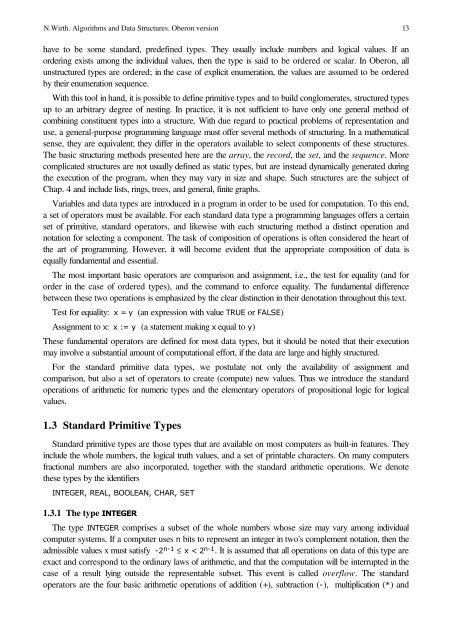Algorithms and Data Structures
Algorithms and Data Structures
Algorithms and Data Structures
Create successful ePaper yourself
Turn your PDF publications into a flip-book with our unique Google optimized e-Paper software.
N.Wirth. <strong>Algorithms</strong> <strong>and</strong> <strong>Data</strong> <strong>Structures</strong>. Oberon version 13<br />
have to be some st<strong>and</strong>ard, predefined types. They usually include numbers <strong>and</strong> logical values. If an<br />
ordering exists among the individual values, then the type is said to be ordered or scalar. In Oberon, all<br />
unstructured types are ordered; in the case of explicit enumeration, the values are assumed to be ordered<br />
by their enumeration sequence.<br />
With this tool in h<strong>and</strong>, it is possible to define primitive types <strong>and</strong> to build conglomerates, structured types<br />
up to an arbitrary degree of nesting. In practice, it is not sufficient to have only one general method of<br />
combining constituent types into a structure. With due regard to practical problems of representation <strong>and</strong><br />
use, a general-purpose programming language must offer several methods of structuring. In a mathematical<br />
sense, they are equivalent; they differ in the operators available to select components of these structures.<br />
The basic structuring methods presented here are the array, the record, the set, <strong>and</strong> the sequence. More<br />
complicated structures are not usually defined as static types, but are instead dynamically generated during<br />
the execution of the program, when they may vary in size <strong>and</strong> shape. Such structures are the subject of<br />
Chap. 4 <strong>and</strong> include lists, rings, trees, <strong>and</strong> general, finite graphs.<br />
Variables <strong>and</strong> data types are introduced in a program in order to be used for computation. To this end,<br />
a set of operators must be available. For each st<strong>and</strong>ard data type a programming languages offers a certain<br />
set of primitive, st<strong>and</strong>ard operators, <strong>and</strong> likewise with each structuring method a distinct operation <strong>and</strong><br />
notation for selecting a component. The task of composition of operations is often considered the heart of<br />
the art of programming. However, it will become evident that the appropriate composition of data is<br />
equally fundamental <strong>and</strong> essential.<br />
The most important basic operators are comparison <strong>and</strong> assignment, i.e., the test for equality (<strong>and</strong> for<br />
order in the case of ordered types), <strong>and</strong> the comm<strong>and</strong> to enforce equality. The fundamental difference<br />
between these two operations is emphasized by the clear distinction in their denotation throughout this text.<br />
Test for equality: x = y (an expression with value TRUE or FALSE)<br />
Assignment to x: x := y (a statement making x equal to y)<br />
These fundamental operators are defined for most data types, but it should be noted that their execution<br />
may involve a substantial amount of computational effort, if the data are large <strong>and</strong> highly structured.<br />
For the st<strong>and</strong>ard primitive data types, we postulate not only the availability of assignment <strong>and</strong><br />
comparison, but also a set of operators to create (compute) new values. Thus we introduce the st<strong>and</strong>ard<br />
operations of arithmetic for numeric types <strong>and</strong> the elementary operators of propositional logic for logical<br />
values.<br />
1.3 St<strong>and</strong>ard Primitive Types<br />
St<strong>and</strong>ard primitive types are those types that are available on most computers as built-in features. They<br />
include the whole numbers, the logical truth values, <strong>and</strong> a set of printable characters. On many computers<br />
fractional numbers are also incorporated, together with the st<strong>and</strong>ard arithmetic operations. We denote<br />
these types by the identifiers<br />
INTEGER, REAL, BOOLEAN, CHAR, SET<br />
1.3.1 The type INTEGER<br />
The type INTEGER comprises a subset of the whole numbers whose size may vary among individual<br />
computer systems. If a computer uses n bits to represent an integer in two's complement notation, then the<br />
admissible values x must satisfy -2 n-1 ≤ x < 2 n-1 . It is assumed that all operations on data of this type are<br />
exact <strong>and</strong> correspond to the ordinary laws of arithmetic, <strong>and</strong> that the computation will be interrupted in the<br />
case of a result lying outside the representable subset. This event is called overflow. The st<strong>and</strong>ard<br />
operators are the four basic arithmetic operations of addition (+), subtraction (-), multiplication (*) <strong>and</strong>
















